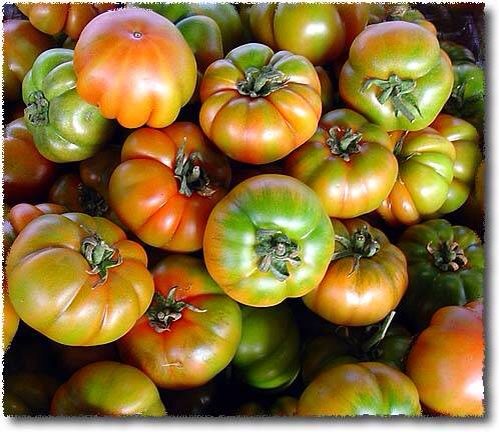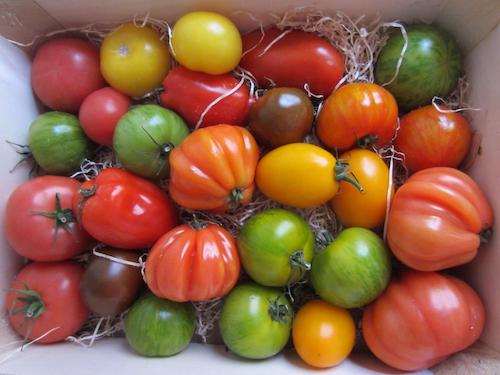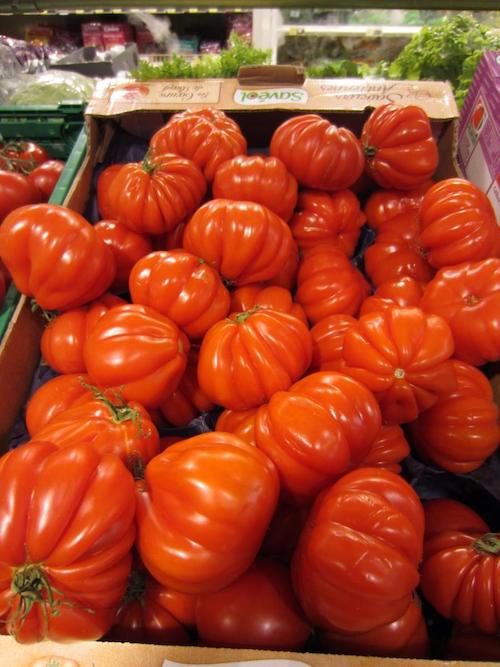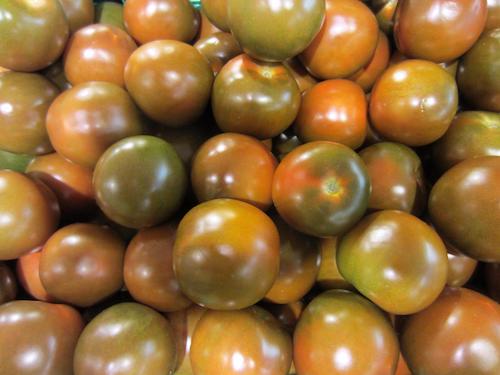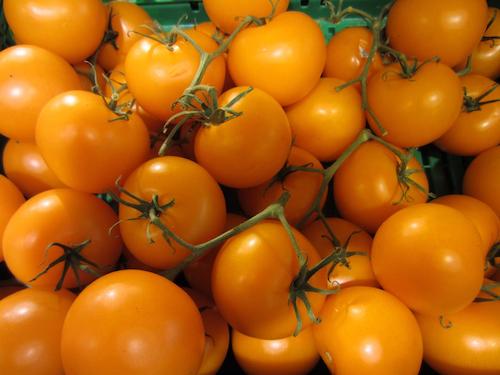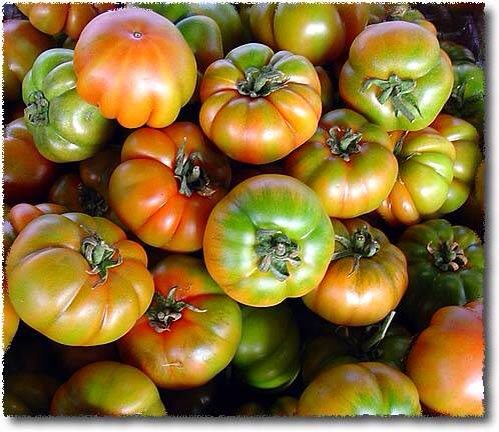One of the greatest things about Paris, as we all know, is the food. The photo shown above is a collection of varietal tomatoes I found in a local produce store. One of the reasons the food is so great is because of the quality of the raw ingredients. In every neighborhood of Paris there are weekly produce markets where you can find an astounding array of fresh fruits and vegetables, cheese, poultry, meat, fish plus non-food items such as household goods, clothes, dishes and so on. In Paris there are unusual forms of fresh produce that are simply unavailable in US markets. I thought I would share some of them with you in this post, although I expect there will be more posts on this subject.
When the tomato was introduced to Europe in the 1500s, The French called it “the apple of love.” The Germans called it “the apple of paradise.” Apparently the tomato was conferred mystical powers and considered an aphrodisiac. Thomas Jefferson first ate a tomato in Paris and sent seeds back to America!
Tomato ‘Costoluto Genovese’ produces flattened, ribbed, beefsteak tomatoes with a meaty texture and a superb flavour. The large fruits can attain enormous sizes, and with a relatively thick skin, they are ideal for grilling. The fluted, old Italian favorite has been around since the early 19th century. Fruit are rather flattened and quite attractive with their deep ribbing. This variety is a standard in Italy for both fresh eating and preserving; known for its intensely flavorful, deep red flesh. Some say it is the secret ingredient to “real” Italian tomato sauce. Some people find the tomato taste too intense in the raw form, the consistency too mealy and prefer it only for tomato sauce, each to their own I suppose. Costoluto means “ribbed” in Italian. Also called the Pomo Doro Rosso Grosso, it is the the Grosse Lisse tomato for Italian gardeners.
Black Russian (Noir de Crimee in French) tomatoes are medium sized black tomatoes that grow on compact plants bearing plenty of dark mahogany-brown fruits, with a delicious blend of sugar and acid. Tomato ‘Black Russian’ is an old variety with a rich, complex flavour that has to be tasted to be believed. Very popular in the Paris culinary scene, especially the black cherry tomatoes. With its dark fruit it looks great in a salad and has an excellent sweet taste with spicy and smoky undertones that are enhanced when dried. The flavours really are deliciously intense and the other great thing about this variety is that it is resistant to most diseases, fruits early and is a heavy producer. What more could you want in a tomato?
This heirloom tomato comes from the Crimea by the Black Sea. The variety is not mentioned in The Vegetable Garden, nor any other black tomatoes so we can assume it did not arrive in Europe before the 1880s. Very similar to, if not the same as Black Russian (Thomas Etty) and/or Black Krim (Kokopelli). Krim is a synonym for Crimea. In fact there are almost 50 varieties of Black Russian tomatoes available today including a black cherry tomato.
“Black Krim” is one of the oldest and most popular heirloom varieties of black tomatoes. Also known as Black Crimea they were found in 1990 on the Isle of Krim in the Black Sea in the former Soviet Union. Black Krim is one of the first heirloom vegetables that many people try growing. It is largely responsible for fueling many growers’ obsessions with heirloom tomatoes and has helped contribute the range of heirloom seed available today.
Simply put, orange tomatoes are tomatoes which are orange, rather than the more conventional red. When people talk about orange tomatoes, they are either referring to certain heirloom tomato varieties which are orange in color, or to a specially bred tomato varietal which has very high amounts of beta-carotene. In either case, the tomato might look a bit weird and certainly distinctive, with a bright orange exterior and an orange interior. However, orange tomatoes taste just like regular tomatoes, although they will of course produce orange ketchup, tomato sauce and juice blends.
In the world of heirloom tomatoes, tomatoes come in a lot of colors. In addition to classic red, heirlooms also come in orange, yellow, green, and purple as you can see from the picture at the top of this post. It is also not uncommon to see tomato varietals which are streaked with multiple colors. Some famous heirloom orange tomatoes include: Dad’s Sunset, Golden Jubilee, Orange King, Sweet Orange, Patio Orange, Dr. Wyche’s Yellow, and Yellow Brandywines. Each of these varieties has a distinctive appearance, texture, and flavor.
Food scientists at Ohio State University in Columbus have grown a special variety of orange tomatoes that may be healthier than garden-variety red tomatoes. The orange tomatoes contain a type of antioxidant, Lycopene, that is more readily used by the body than the type found in red tomatoes, they report. Lycopene is an antioxidant thought to have a number of health benefits such as reducing the risk of cancer, heart disease and age-related eye problems. Lycopene is what gives red tomatoes and other fruits and vegetables their rich color.
They also suggest a simple and nutritious recipe for heirloom tomatoes (credit)
You can use a variety of tomatoes in this simple, but very tasty salad. They’re at their peak during the summer months and worth seeking out at your local grocery store or farmers’ market. Which varieties you choose is up to you, as any and all will work great. Makes 4 servings, about 1 cup each.
Ingredients:
1 Tbs. extra-virgin olive oil
1 Tbs. champagne vinegar or white-wine vinegar
1/2 tsp. sea salt
Freshly ground pepper to taste
1 lb. tomatoes, cut into wedges
2 c. thinly sliced fennel bulb
1/4 c. chopped fresh parsley
1/3 c. toasted pine nuts (see Tip)
Preparation;
Whisk oil, vinegar, salt and pepper in a large bowl until combined. Add your tomatoes, fennel, parsley and pine nuts; toss to coat. Looks delicious to me, be sure to toast the pine nuts.
Finally! I would like to mention a variety of Sicilian tomatoes that look like small Costolutos with a lot of green, found only in the spring in Paris. My friend Jean Luc tells me this is his favorite tomato because of it’s sweet flavor. These are the Pomodora Marinda (meaning Marina tomatoes) pictured above. They are intentionally picked small and studies have shown that tomatoes with a little bit of green have a much pronounced tomato taste (I will post on this later).
I am going to end this tomato-fest for now, Lisa and I will be doing taste tests in a future post.

